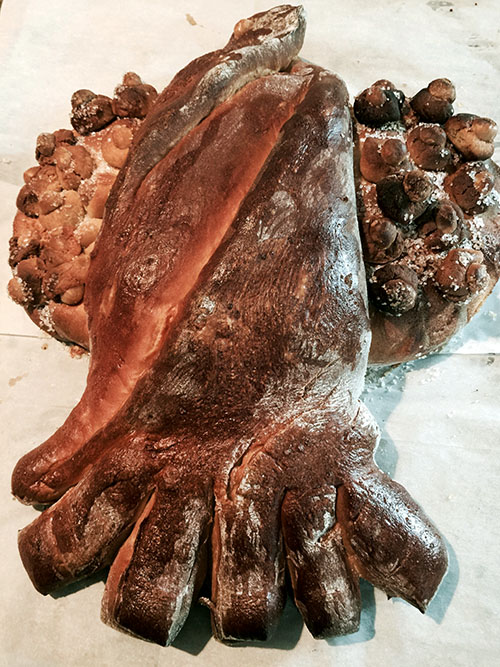
[I] had not considered the obvious parallels of birds and bread and lightness and flight until I made a bird out of bread recently. I had no choice but to make a bird out of bread recently when, in search of an annual Easter bread, I landed on a creature called Columba di Pasqua, a dove — wings spread — made of sweet yeast dough.
An Italian Eastertime tradition, the bread’s origins seem to symbolize those things commonly held to the season — peace, life, spring, renewal. According to “The Italian Baker,†by Carol Field (1985), stories of the bread’s beginnings suggest slightly different (and somewhat sordid) 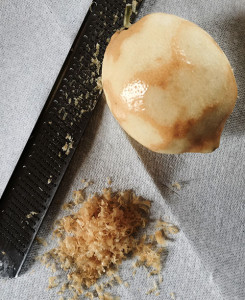 inceptions, from two doves symbolizing the Holy Ghost appearing on the battlefield during Frederick Barbarossa’s attempt to capture Italy for the Holy Roman Empire, to a young Pavia girl’s attempt to defy being a conquest for a king by baking him a sweet bread in the shape of dove, upon which eating, he granted her freedom. Now that’s using your head — and your oven.
inceptions, from two doves symbolizing the Holy Ghost appearing on the battlefield during Frederick Barbarossa’s attempt to capture Italy for the Holy Roman Empire, to a young Pavia girl’s attempt to defy being a conquest for a king by baking him a sweet bread in the shape of dove, upon which eating, he granted her freedom. Now that’s using your head — and your oven.
After looking at pictures of these doves of bread on the Internet, I was relieved to see that, if the shape and interpretation of these examples was any indication, rustic crudeness prevailed, thankfully. My nephew is the sculptor in the family, so I gave myself the space and grace to make my dove of dough and be OK with it looking somewhat rudimentary.
Columba di Pasqua dough is very similar to Panettone, sweet, rich, buttery and egg-y, with a cakeier crumb than other yeast breads. It is also enhanced with lemon zest, in this case, two whole tablespoons.
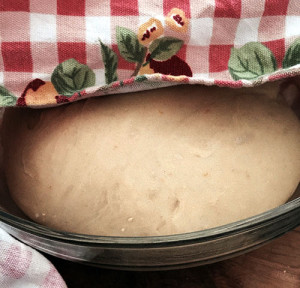 I let my dough hook do the bulk of a 20-minute knead (with my hands involved at the end) and let a slightly heated oven do the lifting of a long first rising for the dough. The dough doubled successfully and was light, yet sturdy enough for the shaping process.
I let my dough hook do the bulk of a 20-minute knead (with my hands involved at the end) and let a slightly heated oven do the lifting of a long first rising for the dough. The dough doubled successfully and was light, yet sturdy enough for the shaping process.
Despite the daunting idea of building a bird out of bread, it was not all that difficult. After cutting the punched-down dough in half, I shaped a longer ovalish rectangle for the wings from one half, then laid a triangle (made from the second dough half) over top of that for the bird’s body.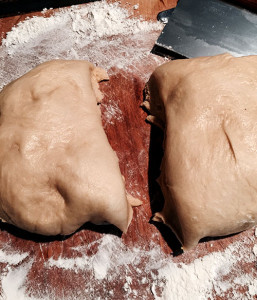
Both the top and the bottom of the triangle are twisted, in opposite directions, to create a head and a tail, which is sliced and fanned out to create feathers. A “beak†is pinched at the dove’s head. To decorate the wings, balls of almond paste, with a blanched almond pressed in each (since I could not find blanched whole almonds, I used macadamia nuts) are placed all over the wingspread. A single nut is pressed into the head for an eye.
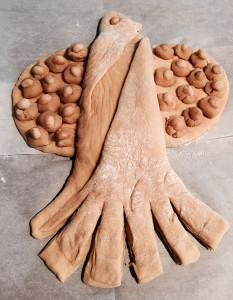 Another shorter rising. I considered my long-held fascination of the flight of birds. Far less awe-inspiring, but still fascinating to me was also the rising of bread. If air could flow around feathers to carry birds into the sky, certainly the gassy air conjured by yeast and flour and heat through dough wings would lend to some lifting.
Another shorter rising. I considered my long-held fascination of the flight of birds. Far less awe-inspiring, but still fascinating to me was also the rising of bread. If air could flow around feathers to carry birds into the sky, certainly the gassy air conjured by yeast and flour and heat through dough wings would lend to some lifting.
The dough dove puffed up. It was almost fearsome, more the size of a parrot than a dove. I brushed it delicately with beaten egg white and added a sprinkle of sparkling sugar.
It baked up darkly beautiful, looking like something from a day when girls sought flight from lascivious kings and made their own ransoms from sweet dough. Eating the tender, lemony bread in thick slices spread generously with butter, I felt sure a king would be so appeased, he would let her go. Of course, she was free to come back…to bake whenever she wanted.
Columba di Pasqua
From “Sunset Breads†(1991)
Makes 1 loaf
1 package active dry yeast
1/4 cup warm water (about 110 degrees)
1/2 cup butter or margarine, softened
1/2 cup plus 2 tablespoons sugar
2 tablespoons grated lemon peel
2 teaspoons vanilla
1/2 teaspoon salt
3 whole eggs
3 egg yolks
1/2 cup warm milk (110 degrees)
5 to 5 1/2 cups all-purpose flour
About 4 ounces almond paste
27 whole blanched almonds
1 egg white, lightly beaten
Sugar for sprinkling
In a small bowl, dissolve yeast in water. In a large bowl, beat together butter, sugar, lemon peel, vanilla, and salt until fluffy. Beat in eggs and egg yolks, one at a time. Mix in milk and dissolved yeast, then gradually beat in 4 1/2 cups of the flour to make a soft dough.
Turn dough out onto a floured board, knead until smooth and shiny (10 to 20 minutes), adding flour as needed to prevent sticking. Place dough in a greased bowl, turn over to grease top. Cover and let rise in a warm place until doubled in bulk (about 1 1/2 hours).
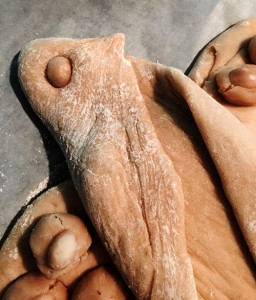 Punch dough down; knead briefly on lightly floured board to release air. Divide in half and shape each ball into a smooth ball. In center of a greased 14-by-17-inch baking sheet. Flatten one dough ball and roll across narrow dimension of pan to make an oval about 11 inches long and 6 inches wide. On a floured board, roll out other ball of dough to make softly outlined triangle, about 16 inches tall and 8 inches across the base. Lay triangle across the oval; fold over narrow end to make head, and pinch firmly to form beak Fold wise end in opposite direction to make tail; gently pull tail into fan shape and cut into 5 strips to simulate feathers.
Punch dough down; knead briefly on lightly floured board to release air. Divide in half and shape each ball into a smooth ball. In center of a greased 14-by-17-inch baking sheet. Flatten one dough ball and roll across narrow dimension of pan to make an oval about 11 inches long and 6 inches wide. On a floured board, roll out other ball of dough to make softly outlined triangle, about 16 inches tall and 8 inches across the base. Lay triangle across the oval; fold over narrow end to make head, and pinch firmly to form beak Fold wise end in opposite direction to make tail; gently pull tail into fan shape and cut into 5 strips to simulate feathers.
Pinch off 26 pieces of almond paste and roll each into a ball. Press a whole almond into each then arrange 13 balls on each of the dove’s wings, pressing balls into dough. Press another whole almond into dough to form dove’s eye.
Let rise in warm place until puffy (about 25 minutes). Brush dove gently with beaten egg white and sprinkle wings generously with sugar. Bake in a preheated 350-degree oven for about 40 minutes or until bread is richly browned — cover loosely with foil for the last 15 minutes to prevent sugared portion from scorching. Let cool on a rack. To serve, cut slices from either body or wings of dove.